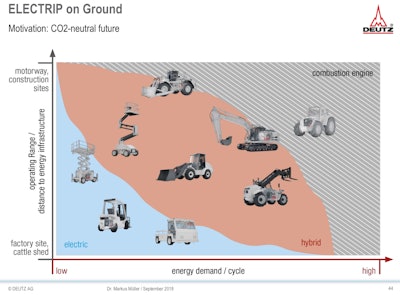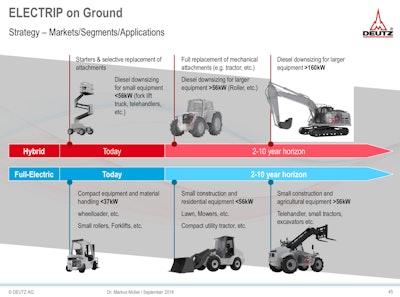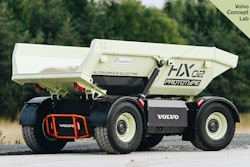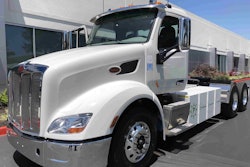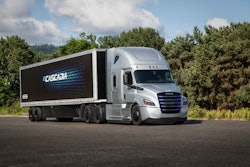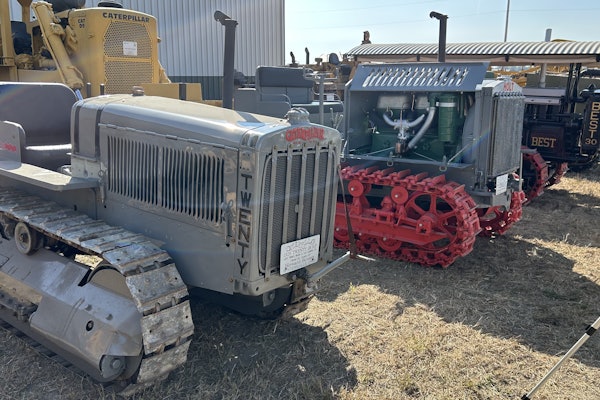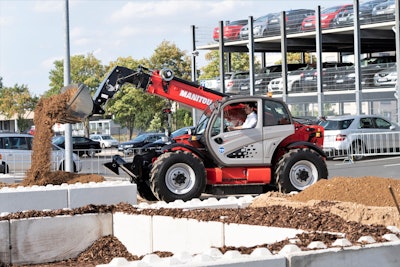 By using an E-Deutz diesel engine and driveline to power a generator and store energy in a battery pack, this Manitou telehandler can downsize from a 3.6 liter/100 horsepower engine to a 2.2 liter/73 horsepower engine and tap 26 horsepower from the batteries and generator to make up the difference.
By using an E-Deutz diesel engine and driveline to power a generator and store energy in a battery pack, this Manitou telehandler can downsize from a 3.6 liter/100 horsepower engine to a 2.2 liter/73 horsepower engine and tap 26 horsepower from the batteries and generator to make up the difference.In the past, an engine manufacturer’s responsibility stopped at the flywheel. Today, an increasing number of engine OEMs are paying as much attention to the drivetrain as they are to the engine itself. And this includes, in many cases, electrified and hybrid drive trains.
Last week, Deutz invited us to Cologne, Germany, to look at its new prototype electric drives, dubbed the E-Deutz portfolio, and hybrid and fully electric demonstration machines including two Manitou and two Liebherr telehandlers.
The fully electric Manitou MT 1135 telehandler has a 360-volt vehicle power supply and an 80-horsepower (60 kilowatt) electric motor with a 30 kilowatt-hour battery, all driven by a Deutz TCD 3.6 liter engine. For the hybrid E-Deutz drive, the company was able to replace the 3.6-liter engine with a Deutz TCD 2.2 liter engine which generates 73 hp (55 kW) boosted by a 26-hp (20 kW) electric motor and 48-volt system in a Manitou MT 1335 telehandler
The hybrid Liebherr TL 432-7 telehandler also downsized from a 3.6 to a 2.2L Deutz engine, while maintaining the same aggregate horsepower combining mechanical and electrical output. In both cases the hybrid machines can be powered mechanically or on nothing but electrical power by storing the energy in a 10 kilowatt-hour battery. Deutz says a 15-percent fuel savings can be achieved depending on load cycle and application.
Torqueedo
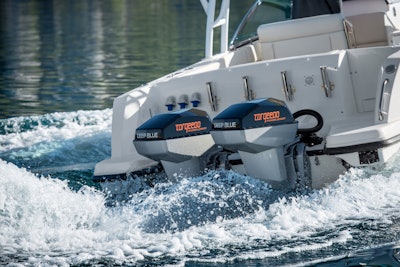 By acquiring Torqueedo, a manufacturer of electric drive marine motors, Deutz was able to cut five years out of the technology development needed to electrify their diesel engine powertrains.
By acquiring Torqueedo, a manufacturer of electric drive marine motors, Deutz was able to cut five years out of the technology development needed to electrify their diesel engine powertrains.Rather than develop its own electric drives from scratch, Deutz bought another German firm Torqueedo, which manufacturers electric drive motors for watercraft—everything from tiny fishing kayaks to trolling motors, rescue watercraft and large ferries. Completed just a year ago, the acquisition gave Deutz industrial scale, ready-made technology solutions for battery management, electric motors, controllers and the software that ties it all together says Michael Wellenzohn, a member of the Deutz board of management.
Deutz cited three main reasons to invest in electrified drivelines, all tied to the company’s goal of becoming “CO2 neutral.” This include:
- Reduced fuel consumption.
- Lowered exhaust emissions.
- Buyers of rental machines want less complexity when it comes to engines and electrification enables Deutz to keep engines small enough to avoid complex exhaust aftertreatment systems such as selective catalytic reduction technology (SCR).
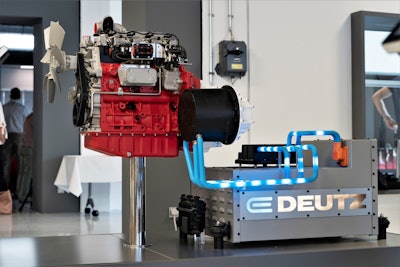 Horsepower originates mechanically in the engine, but once converted into electric power can be routed around the machine with ease.
Horsepower originates mechanically in the engine, but once converted into electric power can be routed around the machine with ease.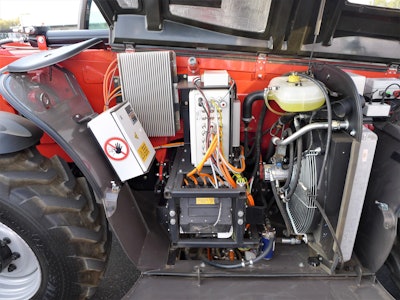 The batteries and power control modules are mounted to the left of the cab.
The batteries and power control modules are mounted to the left of the cab.By 2020, Wellenzohn anticipates between 5 and 10 percent of Deutz’s market will be electric drives with China as the biggest customer. There is a big push on for electrification of drivelines in China to help combat that countries serious air pollution problems. In fact the mayor of Beijing attended the first day of Deutz’s event in Cologne.
While the machine’s we saw were still in the prototype phase, Deutz plans to start manufacturing modular hybrid drives in 2019 and selling hybrids and all-electric products by 2020, says Dr. Frank Hiller, Deutz’s CEO. By 2022-2023 Hiller says the company anticipates hybrids and electric drive units will account for 5-to 10-percent of the company’s revenue. Since the company projects sales above 200,000 engines by 2022, that could mean anywhere from 10,000 to 20,000 electrified machines in the market running on E-Deutz systems in the next few years.
Beyond electric
Although electrification was the focus of our event last week, Deutz also showed us other technologies they are working on that will help meet the goals of sustainability and environmental protection in the CO2-neutral future.
The plan is to investigate and develop a full range of technologies across two paths. The first path is electrification including the 48-volt mild hybrid systems and 360-volt full hybrid machines we saw followed by electric vehicle batteries and finally plugging into a grid of renewable electricity. The second path encompasses renewable fuel technology including biodiesel, multi-fuel (CNG, propane and mixed fuels), hydrogen and synthetic fuels.
Renewable fuels will pose challenges to the chemical industry as well as engine manufacturers, says Hiller. And while the viability of synthetic fuels are some years in the future, these offer the best option for reducing greenhouse gasses and environmental problems he says.
Hydrogen power
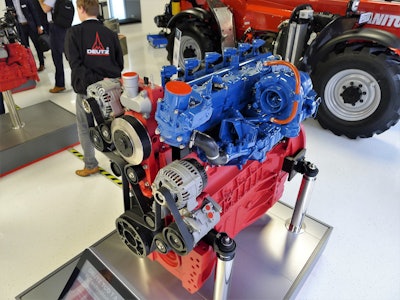 Deutz is also working on a prototype hydrogen powered engine which would need no exhaust aftertreatment and create zero emissions.
Deutz is also working on a prototype hydrogen powered engine which would need no exhaust aftertreatment and create zero emissions.In their newly constructed Innovation Center, Deutz also has a prototype hydrogen powered engine based on the Deutz TCD 7.8 liter engine. The hydrogen powered version is modified with a hydrogen fuel injection system, a different cylinder head and ignition system and customized piston and ring package. Tests on this engine have generated up to about 240 horsepower (180 kW), but to be competitive with the diesel fuel version Deutz would like to see it create at least 335 horsepower (250 kW), says Dr. Marcus Müller, senior vice president, product development and technology.
This multiple-path, multiple technology strategy is necessary due to the wide range of applications and power requirements in the off-road equipment industry. As the two charts chart below detail, electrification is well suited to intermittent-use machines such as lift and access equipment. But as the applications demand greater, power, torque and production, some form or combination of hybrid and internal combustion power will be needed.
